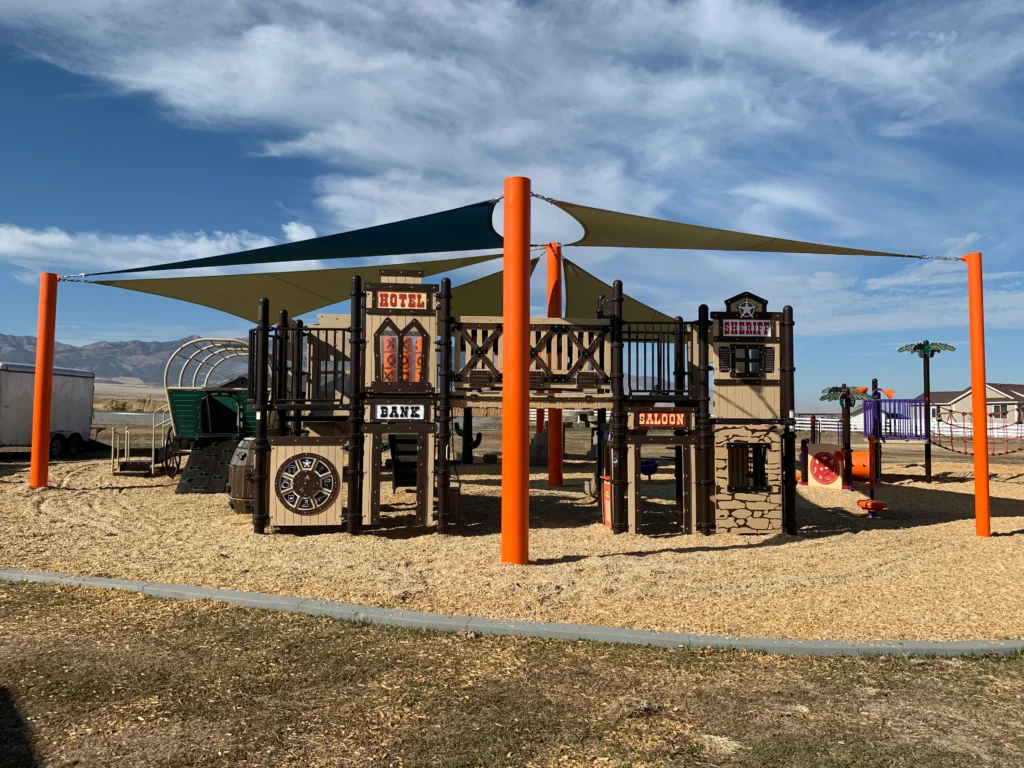Summer Shade is easy with LuckyDog Recreation
When planning the location for your new playground, shade should be a primary component of the planning process, not an afterthought. In the high desert west of Idaho, Utah and Wyoming we often forget that we have extremes of cold and hot for several weeks each year.
Being in direct sunlight can make the air feel 10-15 degrees warmer than it actually is because of the sun's rays touching your skin. Incorporating shade from landscaping elements such as trees and shrubs reduces heat from the sun’s rays. Evapotranspiration (the process by which a plant actively moves and releases water vapor) from trees can reduce surrounding air temperatures as much as 6° F.


Consider natural shade that can be provided by trees. Never be in too big a hurry to yank out an existing tree. Even if it has to be incorporated into the play area, LuckyDog’s play designers can help you keep that natural element to help shade south-facing play equipment that would otherwise be unusable on a really hot day or later in the afternoon.
Existing buildings can also provide great shade. In the planning process, consider that you don’t allow the eave overhang of a building to extend into the “use zone” of a playground. Also, consider whether or not water runoff from a building will cause excess water to puddle into a playground pit. Other than that, a building that can provide shade to a playground on the hottest part of the day is a cost-effective win.


If you don’t have trees or a building, LuckyDog’s shade experts can help you craft and create summer shade to help playground surfaces stay cool on hot summer days.
Check out these LuckyDog tips:
- Create shaded play spaces under taller decks or in and around equipment pieces like clubhouses. The space created under a tall deck is often void of equipment, but a good designer can help you maximize these areas. A taller piece of equipment can be strategically placed to provide shade to a picnic table or buddy bench so kids can be out of the sun and still engage with friends.
- If you’ve built your playground but need a budget-friendly addition, a shade umbrella is perfect. With a single post design this shade option is simple to install, and at 15-16’ across it can cast a large shadow over a big play area. Use these to shade the bottoms of slides or smaller freestanding pieces, carefully positioning to maximize the angles at key times of the day.
- If you’re just getting started on your new playground design, ask for the inclusion of shade sails or large roofs attached to your play structure. Incorporating shade into your design from the start will make your project usable through the whole outdoor season and save you from having to come back and add shade later.
- As a playground planner or fundraiser, you may have to “sell” the idea of shade on a grant application, to your City Council, or other Board members that has a say in whether or not your playground will be shaded. Knowing and being able to articulate the primary reason for adding shade requires you to be educated and to educate. Download a guide for the prevention of cancer from the Surgeon General: Cancer Prevention
- Download a report from a task force for the prevention of skin cancer targeting children’s parents and caregivers: Parents and Caregivers.pdf
- Take advantage of the American Academy of Dermatology's (AAD) Shade Structure Program - that awards funds to schools, day-cares, parks, and other non-profit organizations for installing shade structures where children learn and play. Each shade structure award is a maximum of $8,000, which includes the cost for shade structure materials and installation. Learn more
Let us know you are ready to talk about adding shade to your play space!
Have questions? Reach out to your LuckyDog Play Designer today!